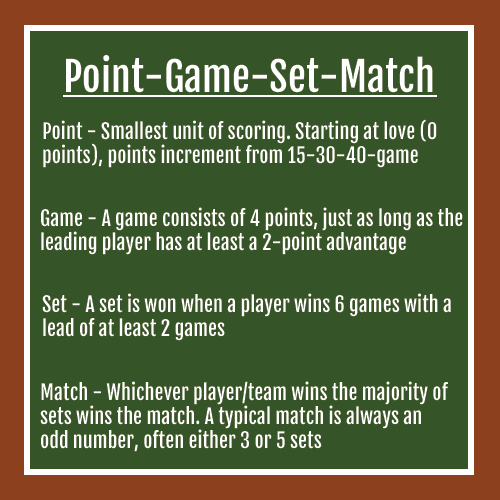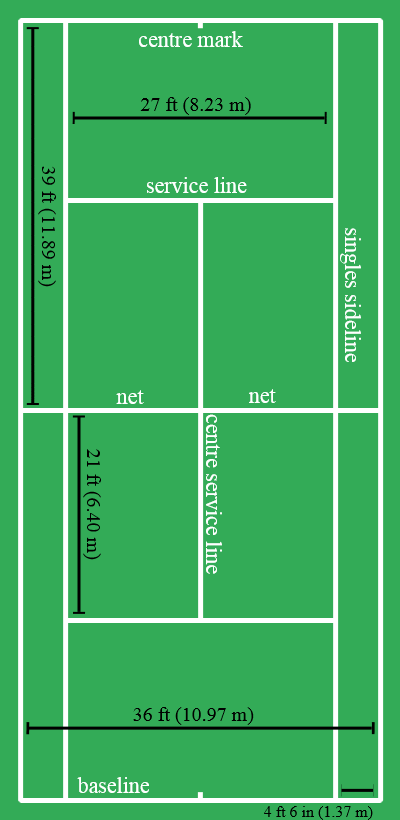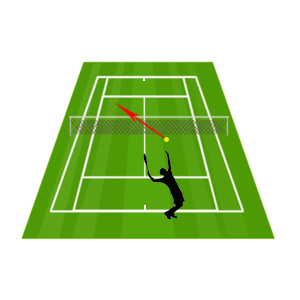Tennis Rules
Want to learn how to play tennis? Or, do you want to understand what’s going on when you’re at a tournament or watching tennis on TV? Obviously, you’re going to need to know the rules of tennis in order to understand the sport. However, they can be a little complicated to remember at first, but we’ll walk you through every little detail as best and as simply as we can. So, read on if you want to learn more about the official tennis rules recognized by most tennis organizations.
Tennis Rules
First of all, the rules of tennis are different (although mostly similar) for singles matches and doubles matches. But before we go over that stuff, let’s review some of the general tennis rules and regulations that apply to all of tennis before we learn how to play tennis for singles and doubles.
General Rules of Tennis
- A ball must land within bounds for play to continue; if a player hits the ball outside of bounds, this results in the loss of the point for them.
- Players/teams cannot touch the net or posts or cross onto the opponent’s side.
- Players/teams cannot carry the ball or catch it with the racquet.
- Players cannot hit the ball twice.
- Players must wait until the ball passes the net before they can return it.
- A player that does not return a live ball before it bounces twice loses the point.
- If the ball hits or touches the players, that counts as a penalty.
- If the racquet leaves the hand or verbal abuse occurs, a penalty is given.
- Any ball that bounces on the lines of boundary are considered good.
- A serve must bounce first before the receiving player can return it.
Equipment
- Racquet – A racquet is comprised of a handle, a frame, and strings that are bound in a crisscross weaving pattern. A racquet’s frame should not exceed 32 inches in length, with a handle no longer than 12.5 inches in width, and a surface no more than 15.5 inches in overall length or 11.5 inches in width. There can also be no objects or devices on the racquet except for ones that prevent vibration and wear and tear.
- Ball – A tennis ball is white or yellow in color for tournaments, with measurements of 2-1/2 to 2-5/8 inches in diameter and weighing anywhere from 2 to 2-1/16 ounces. The elasticity of the ball and the uniform outer surface are also determined by approved specifications.
Scoring
- Points – Smallest unit of measurement. Points increment from Love(0)-15-30-40-game.
- Games – Games consist of 4 points each, and is won when a player reaches 4 points with at least a 2 point advantage.
- Sets – A set consists of 6 games and is won by the player/team who reaches 6 games first with least a 2 point lead.
- Advantage Set – If a game score of 6-6 is reached and advantage set rules are used, a player/team can only win a set with a 2 game lead.
- Matches – A match is usually played as best of 3 or best of 5 sets.
- Deuce – Occurs if a score of 40-40 is reached. In order to win the game, a player/team must win 2 consecutive points in order to take the game. If a player wins one point, they have advantage, but if they lose the next point, the score returns to deuce.
- Tie-break game – If a game score of 6-6 is reached and tie-break set rules are used, players must play a tie-break game in order to decide who wins the set. In a tie-break game, a player/team must reach 7 points with a two point advantage to win. For the serving format of a tie-break game, player 1 serves for the first point, player 2 serves for the next two points, player 1 serves for the next two points after that, etc.
You can find a more in-depth look at how tennis is scored here and all the terms that are used (including alternate tennis rules terms) here.


Official measurements of a typical tennis court
What Do the Lines Mean?
- Baseline – The baselines are the lines on either end of the court that determines the boundaries of play going lengthwise. They are also where a player serves behind.
- Center Mark – The center mark determines the two halves of the tennis court. It mainly helps with service to determine where a player should stand prior to serving.
- Center Line – The center line divides the two service boxes into a distinct left service box and right service box on either side of the court. Landing a serve on the line is considered good.
- Net – The net stands 3 feet and 6 inches high where the posts lie while the middle of the net is 3 feet tall, with the posts 3 feet outside of the court on either side. Hitting a ball into the net is considered an out while any ball that hits the net cord and falls onto the other side is considered good except for a serve, which allows for a re-do, or let.
- Service Line – The service line separates the forecourt from the back court, and it also marks the length of the service box.
- Singles Sideline – The singles sideline is the innermost line running lengthwise and determines the boundary of play for singles matches as well as the width of the service box.
- Doubles Sideline – The doubles sideline is the outermost line running lengthwise and is only used in doubles matches.
Who Serves First?
A flip of the coin or spin of the racket, known as the toss, determines which player or team serves first. If called correctly, the player or team that did so chooses who serves first. The player/team who did not call it correctly decides which side of the court they want to play on first.
Rally
The rally consists of the exchange of shots after the serve is made until a player/team makes a mistake and loses the point. Any shot that is hit within bounds is considered good and allows the rally to continue. If you want to learn how to play tennis, you will need to know how to rally consistently.
Serving and Choosing Sides
- Foot Fault – A foot fault is when a player steps into the court or crosses the center mark before they have made contact with the ball. This results in the loss of the serve.
- Proper Serve – A player serves on the right side of the court at the beginning of each game, with the goal of serving the ball into the diagonal service box. If the serve lands in the correct service box, play can continue. The server switches to serve on the left side for the next point, and vice versa until the game is over.

Players serve from the right side of the court at the beginning of each game, trying to land their shot into the opposite side’s diagonal service b
- First Service – The server is allowed two chances to land their ball into the service box. The first attempt is known as the first service. Failing the first service leads to the second service.
- Second Service – The second attempt is known as the second service. Failing the second service results in the loss of the point.
- Let – A let is a re-do given to a player who serves although the ball hits the net cord before falling into the correct service box. You are allowed an infinite amount of lets, although it does not happen often.
- Order of Service – The player/team who wins the toss serves first (team that wins chooses which player serves). If playing singles matches, players alternate between serving and receiving every game. If playing doubles matches, teams alternate between serving and receiving every game, with each player on a team getting the chance to serve before the cycle repeats.
- Switching Sides – Players/teams switch sides for every odd-numbered game (so, games 3, 5, 7 etc.)
Singles Vs. Doubles Tennis Rules
The tennis rules for singles and doubles matches are a little different, although mainly regarding serving order and court size. Doubles tennis rules are just slightly adapted to make room for an extra player on either side of the court, but for the most part, doubles tennis rules are very much the same as singles matches. So, here’s how to play tennis for singles and doubles matches.
Singles Tennis Rules
Court Size
A singles court uses the innermost sideline and measures a total of 27 feet wide by 78 feet long.
Serving Order
The player who wins the toss chooses who serves first. Whomever is serving first serves for the entire duration of the first game. After the game, the next server will be the player who received last, serving for the duration of the second game. For every odd-numbered game, players switch sides of the court.
Tie-Break Serving Order
If a score of 6-6 is reached and tie-break rules are used, a tie-break game is played in order to determine which player wins the set. For a tie-break game, the goal is to reach 7 points first with a lead of at least 2, and doing so results in the win of the set. The player who serves first is the player who would normally serve after 6-6, or 12 games.
The serving order for a tie-break is as follows:
- Point 1: Player A
- Point 2: Player B
- Point 3: Player B
- Point 4: Player A
- Point 5: Player A
- Point 6: Player B
- Point 7: Player B
- Point 8: Player A
- Point 9: Player A
- …
Match Format
A singles match is often played to the best of 3 sets, although some mens singles tournaments play to the best of 5. It really all depends on the preferences of the players on the rules of the tournament.
Doubles Tennis Rules
Court Size
A doubles court uses the outermost sideline and measures a total of 36 feet wide by 78 feet long.
Serving Order
The team who wins the toss chooses which team serves first, and that team will choose which of them will serve first. Whoever is serving first serves for the entire duration of the first game. After the game, the next server will be chosen by that team and will serve for the duration of the second game. For every odd-numbered game, teams switch sides of the court, and the player who hasn’t served yet from the first game must now serve, and the player who hasn’t served yet from the second team serves afterward, and so on.
Tie-Break Serving Order
The serving order for a tie-break is as follows:
- Point 1: Player A
- Point 2: Player X
- Point 3: Player X
- Point 4: Player B
- Point 5: Player B
- Point 6: Player Y
- Point 7: Player Y
- Point 8: Player A
- Point 9: Player A
- …
Match Format
A doubles match is often played to the best of 5 sets.
